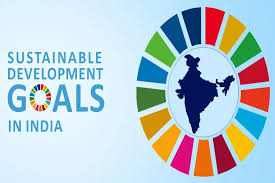India’s SDG Ranking in 2025 marked a significant milestone, as the country secured a spot among the top 100 nations in the United Nations Sustainable Development Goals (SDGs) Index. According to the Sustainable Development Report 2025, India now ranks 99th out of 193 countries, with a score of 67 points. This achievement reflects a steady and noteworthy improvement in India’s commitment to the global 2030 Agenda for Sustainable Development.
The SDG Index is a critical tool that evaluates countries’ performance across 17 Sustainable Development Goals adopted by UN member states in 2015. These goals aim to eradicate poverty, ensure quality education, achieve gender equality, promote sustainable economic growth, and protect the environment, among others.
Understanding the SDG Index
The SDG Index is compiled and published by the UN Sustainable Development Solutions Network (SDSN), with renowned economist Jeffrey Sachs spearheading the analysis. It assesses countries based on a broad set of socioeconomic and environmental indicators, offering a comprehensive picture of national progress.
India’s climb to the 99th rank signals substantial development across sectors such as education access, healthcare coverage, and infrastructure expansion, though challenges still remain in areas like climate resilience and income inequality.
SDG Ranking: Regional and Global Comparison
Globally, the 2025 report reveals that Nordic countries continue to lead the pack, with Finland maintaining the top position, followed by Sweden and Denmark. These nations exhibit consistently high performance across all 17 goals, largely due to robust welfare systems, environmental sustainability efforts, and inclusive governance.
In Asia, China ranks at 49, while the United States occupies the 44th position. Among South Asian nations, Bhutan leads at 74, followed by Nepal, Bangladesh, and then India at 99. India’s placement, though behind some neighbors, still represents notable upward momentum in the region.
SDG Ranking: Progress and Ongoing Challenges
Despite India’s improved SDG ranking, the 2025 report indicates that only 17% of SDG targets worldwide are on track to be met by the 2030 deadline. This shortfall is attributed to persistent conflicts, financial constraints, and climate-related disruptions.
In India, significant gains have been recorded in the following areas:
- Access to electricity across rural and remote areas
- Expansion of mobile broadband services
- Reduction in under-five child mortality
However, progress remains uneven. For instance:
- Obesity rates and non-communicable diseases are rising.
- Press freedom and civil liberties have seen backsliding in various global assessments.
- Environmental indicators, especially air pollution and land degradation, continue to be pressing issues.
Reforming Global Financial Architecture to Boost SDG Ranking
A major highlight of the 2025 SDG report is its call to reform the global financial system. It underscores the asymmetry in capital flows, where wealthier nations attract more investments while developing countries face fiscal limitations despite having significant growth potential.
This imbalance is likely to be addressed in the upcoming International Conference on Financing for Development, which aims to design equitable funding mechanisms for sustainable development efforts worldwide. For India, improved access to global financial resources could accelerate its progress toward climate action, digital transformation, and public health goals.
India’s Role in Global Multilateralism and SDG Ranking Progress
An interesting aspect of the SDG report is the ranking of countries based on their commitment to multilateralism. While small Caribbean nations like Barbados, Jamaica, and Trinidad and Tobago lead in this metric, the United States ranks last for the second consecutive year—primarily due to its withdrawal from key international treaties and climate agreements.
India, meanwhile, continues to play a constructive role in global forums, especially in advocating for climate equity, South-South cooperation, and inclusive trade policies. As a key voice among developing nations, India’s multilateral engagement strengthens its SDG positioning.
Looking Ahead: India’s SDG Pathway
India’s ascent to the 99th spot in the SDG Index 2025 demonstrates progress but also highlights the work that lies ahead. With only five years remaining before the 2030 deadline, strategic interventions, policy coherence, and inclusive governance will be vital.
Strengthening climate action, addressing urban-rural disparities, investing in education, and improving gender equity must remain top priorities. Furthermore, enhancing state-level implementation and real-time monitoring of SDG indicators can help India move further up in global rankings.
Conclusion
India’s SDG Ranking in 2025 is not just a number—it represents the country’s evolving dedication to sustainable and inclusive development. As global challenges grow more complex, India’s continued advancement in the SDG Index will depend on bold policy choices, grassroots empowerment, and international cooperation. With sustained effort, India is well-poised to turn its SDG commitments into impactful realities by 2030.



